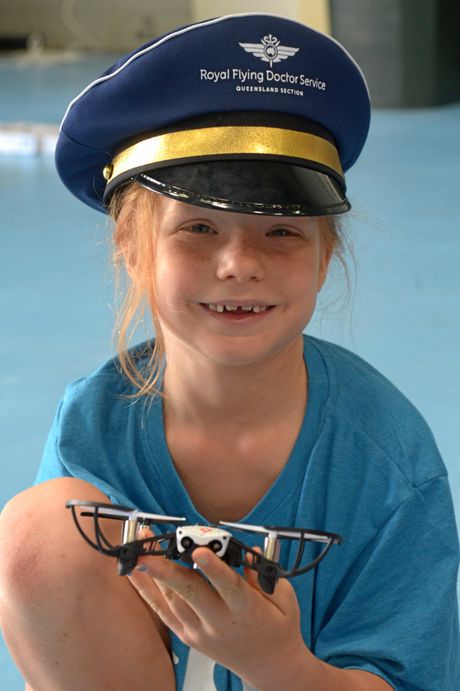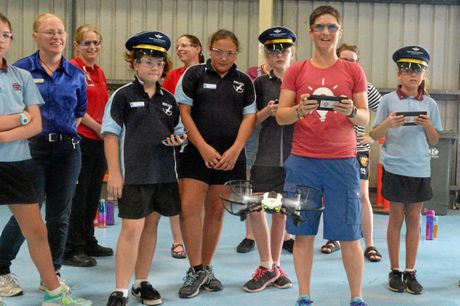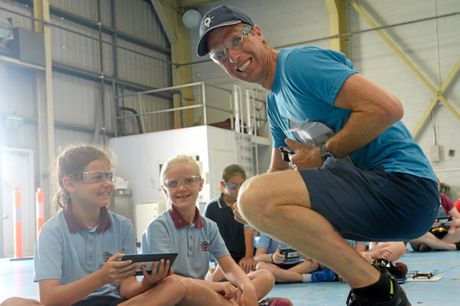GIRLS from Byfield and Keppel Sands had the opportunity to pilot drones over a ‘miniature Great Barrier Reef’ during the SheMaps roadshow yesterday.
CQ primary students were given a twenty-minute course in safety, flight theory and navigation before flying drones within the Royal Flying Doctor Service hangar.
Husband-and-wife team Paul Mead and Karen Joyce volunteered to visit the RFDS in Rockhampton while travelling between Cairns and Brisbane.
Paul Mead of SheMaps with Ebony Wade and Elli Fitchen Jann Houley
Ms Joyce is a senior lecturer in geospatial science at James Cook University in Cairns and her husband has a background in military training.
The couple formed the company SheMaps three years ago to counter the scarcity of women entering the workforce in STEM (science, technology, engineering and mathematics) roles.
“Australia haemorrhages female talent in STEM disciplines from as early as primary school and many people believe that all scientists wear a white lab coat,” they said.
“We are on a mission to increase the diversity IN STEM, through the magic of drones and geospatial science.”
They have delivered the program to more than 3,500 people around Australia, the UK and US, using off-the-shelf kits which cost less than $2,000 for five drones.
Their goal is to familiarise teachers with the technology so they can nurture future generations of scientists and technicians.

Hamish Mead has been flying drones since he was five Jann Houley
Ms Joyce has been mapping the Great Barrier Reef since the late 1990s but the advent of drone technology transformed her research over the last five years.
“The previous satellite images of coral and seagrass habitats, for example, showed little detail but now the drone images show individual sea stars and sea cucumbers clear as day,” she said.
Wearing their RFDS pilot hats, students took turns to manually hover the flying machines over a map of the reef before being given a mission to code the drones.
“Essentially, it’s a miniature of a day of Karen’s life mapping the reef,” Mr Mead said.

Karen Joyce of SheMaps with primary students and staff from Keppel Sands and Byfield schools Jann Houley
Head of RFDS’ Clinical Governance, Trent Dean hinted there are big moves afoot to incorporate drones into the delivery of medical help and support, especially in remote areas.
He said the RFDS has always championed innovation, from Alfred Traeger’s experiments with pedal powered radio to the introduction of the B350 Beechcraft aircraft into Australia.
“We’re thrilled to have SheMaps.com volunteer to visit us today and we’re hoping to work together in helping them offer this workshop to rural schools,” he said.
“The Queensland area is primed for drones, and there are important partnerships underway between RFDS and other partners which are going to change the face of rural medicine.”
The RFDS service already partners with JCU, QUT, UQ and CQUniversity to name a few organisations in sourcing and upskilling both pilots and medical staff.
Mr Dean said there is not one, but two big announcements on the horizon regarding partnered projects which will keep Queensland at the forefront of clinical excellence.
“They’re very exciting projects but we can’t share any details yet.”
The SheMaps co-founders were inspired to begin the company after Karen travelled with the National Science Week celebrations, her husband Paul said.
“There is such a small per cent of women entering the STEM workforce and it’s for the wrong reasons,” he said.
“We, as adults, bring an unconscious bias into our dealing with girls about what they can and should do in the future.”
He points to research which shows girls’ confidence in STEM studies drop drastically at around 9-11 years (compared with around 16 years for boys).
“In fact, we see that girls are actually better at geospatial activities at this age because they are more methodical,” he said.
“Boys generally rip and bust stuff.”
“Telling them there’s a difference between girls’ jobs and boys’ jobs, that’s why only 27 per cent of people entering into STEM subjects at school and then into the workplace are women.”
SheMaps’ purpose is to bring diversity into how we perceive science, and who does it.
The company’s curriculum, which aligns with school curriculum and industry standards, is designed to familiarise staff as well as students.
“If a teacher is fearful of technology, then the kids will pick up on that,” he said.
“We just need to facilitate them working with it to raise students’ confidence.”
Mr Mead points to the Office of the Chief Scientist’s 2016 paper, Busting Myths about Women in STEM which dispels four “damaging and persistent myths” facing women in STEM and highlight the need to support women to purse careers in those areas.
Those myths are: girls are bad at maths; most women are disinterested in careers in engineering, physics and ICT; the gender pay gap doesn’t exist; and the battle against sexism in science has been won.
 Unmanned Aerial Vehicle The latest drone news
Unmanned Aerial Vehicle The latest drone news




